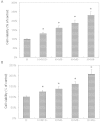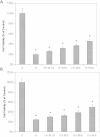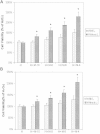Effects of melatonin and its receptor antagonist on retinal pigment epithelial cells against hydrogen peroxide damage
- PMID: 22773902
- PMCID: PMC3388983
Effects of melatonin and its receptor antagonist on retinal pigment epithelial cells against hydrogen peroxide damage
Abstract
Purpose: Recently, we reported finding that circulating melatonin levels in age-related macular degeneration patients were significantly lower than those in age-matched controls. The purpose of this study was to investigate the hypothesis that melatonin deficiency may play a role in the oxidative damage of the retinal pigment epithelium (RPE) by testing the protective effect of melatonin and its receptor antagonist on RPE cells exposed to H(2)O(2) damage.
Methods: Cultured human RPE cells were subjected to oxidative stress induced by 0.5 mM H(2)O(2). Cell viability was measured using the microculture tetrazoline test (MTT) assay. Cells were pretreated with or without melatonin for 24 h. Luzindole (50 μM), a melatonin membrane-receptor antagonist, was added to the culture 1 h before melatonin to distinguish direct antioxidant effects from indirect receptor-dependent effects. All tests were performed in triplicate.
Results: H(2)O(2) at 0.5 mM decreased cell viability to 20% of control levels. Melatonin showed dose-dependent protective effects on RPE cells against H(2)O(2). Cell viability of RPE cells pretreated with 10(-10), 10(-8), 10(-6), and 10(-4) M melatonin for 24 h was 130%, 160%, 187%, and 230% of cells treated with H(2)O(2) alone (all p<0.05). Using cells cultured without H(2)O(2) as the control, cell viability of cells treated with H(2)O(2) after pretreatment with 10(-10)-10(-4) M melatonin was still significantly lower than that of the controls, suggesting that melatonin significantly decreased but did not completely abolish the in vitro cytotoxic effects of H(2)O(2). Luzindole completely blocked melatonin's protective effects at low concentrations of melatonin (10(-10)-10(-8) M) but not at high concentrations (10(-6)-10(-4) M).
Conclusions: Melatonin has a partial protective effect on RPE cells against H(2)O(2) damage across a wide range of concentrations (10(-10)-10(-4) M). This protective effect occurs through the activation of melatonin membrane receptors at low concentrations (10(-10)-10(-8) M) and through both the direct antioxidant and indirect receptor activation effects at high concentrations (10(-6)-10(-4) M).
Figures






Similar articles
-
Melatonin and retinal cell damage: molecular and biological functions.Naunyn Schmiedebergs Arch Pharmacol. 2025 Apr;398(4):3199-3212. doi: 10.1007/s00210-024-03575-w. Epub 2024 Nov 9. Naunyn Schmiedebergs Arch Pharmacol. 2025. PMID: 39520554 Review.
-
Melatonin protects human retinal pigment epithelial (RPE) cells against oxidative stress.Exp Eye Res. 2004 Jun;78(6):1069-75. doi: 10.1016/j.exer.2004.02.003. Exp Eye Res. 2004. PMID: 15109913
-
Epigallocatechin gallate (EGCG) prevents H2O2-induced oxidative stress in primary rat retinal pigment epithelial cells.Curr Eye Res. 2014 Sep;39(9):944-52. doi: 10.3109/02713683.2014.885532. Epub 2014 Feb 21. Curr Eye Res. 2014. PMID: 24559018
-
Wogonin modulates hydroperoxide-induced apoptosis via PI3K/Akt pathway in retinal pigment epithelium cells.Diagn Pathol. 2014 Nov 29;9:154. doi: 10.1186/s13000-014-0154-3. Diagn Pathol. 2014. PMID: 25432585 Free PMC article.
-
Melatonin antagonizes oxidative stress-induced mitochondrial dysfunction in retinal pigmented epithelium cells via melatonin receptor 1 (MT1).J Toxicol Sci. 2018;43(11):659-669. doi: 10.2131/jts.43.659. J Toxicol Sci. 2018. PMID: 30404999
Cited by
-
Stem Cell Derived Retinal Pigment Epithelium: The Role of Pigmentation as Maturation Marker and Gene Expression Profile Comparison with Human Endogenous Retinal Pigment Epithelium.Stem Cell Rev Rep. 2017 Oct;13(5):659-669. doi: 10.1007/s12015-017-9754-0. Stem Cell Rev Rep. 2017. PMID: 28730556 Free PMC article.
-
Protective Effect of Melatonin against Oxidative Stress-Induced Apoptosis and Enhanced Autophagy in Human Retinal Pigment Epithelium Cells.Oxid Med Cell Longev. 2018 Aug 5;2018:9015765. doi: 10.1155/2018/9015765. eCollection 2018. Oxid Med Cell Longev. 2018. PMID: 30174783 Free PMC article.
-
Melatonin in Retinal Physiology and Pathology: The Case of Age-Related Macular Degeneration.Oxid Med Cell Longev. 2016;2016:6819736. doi: 10.1155/2016/6819736. Epub 2016 Sep 5. Oxid Med Cell Longev. 2016. PMID: 27688828 Free PMC article. Review.
-
Melatonin receptor agonist protects against acute lung injury induced by ventilator through up-regulation of IL-10 production.Respir Res. 2020 Mar 6;21(1):65. doi: 10.1186/s12931-020-1325-2. Respir Res. 2020. PMID: 32143642 Free PMC article.
-
Melatonin and retinal cell damage: molecular and biological functions.Naunyn Schmiedebergs Arch Pharmacol. 2025 Apr;398(4):3199-3212. doi: 10.1007/s00210-024-03575-w. Epub 2024 Nov 9. Naunyn Schmiedebergs Arch Pharmacol. 2025. PMID: 39520554 Review.
References
-
- Rein DB, Wittenborn JS, Zhang X, Honeycutt AA, Lesesne SB, Saaddine J, Vision Health Cost-Effectiveness Study Group Forecasting age-related macular degeneration through the year 2050: the potential impact of new treatments. Arch Ophthalmol. 2009;127:533–40. - PubMed
-
- Hogg R, Chakravarthy U. AMD and micronutrient antioxidants. Curr Eye Res. 2004;29:387–401. - PubMed
-
- Cai J, Nelson KC, Wu M, Sternberg P, Jr, Jones DP. Oxidative Damage and protection of the RPE. Prog Retin Eye Res. 2000;19:205–21. - PubMed
-
- Zarbin MA. Current concepts in the pathogenesis of age-related macular degeneration. Arch Ophthalmol. 2004;122:598–614. - PubMed
Publication types
MeSH terms
Substances
LinkOut - more resources
Full Text Sources
Medical
